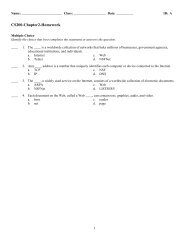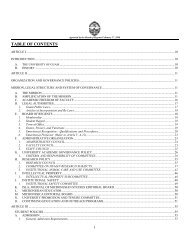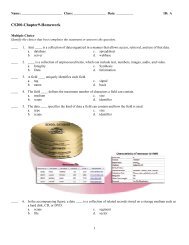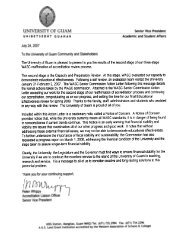Guam Business Resource Guide
Guam Business Resource Guide
Guam Business Resource Guide
You also want an ePaper? Increase the reach of your titles
YUMPU automatically turns print PDFs into web optimized ePapers that Google loves.
U.S. DNB website at www.dnb.com. Once you have<br />
obtained your D-U-N-S number, you may proceed to<br />
the CCR registration page at www.ccr.gov. Prior to<br />
beginning your registration, it is recommended you<br />
download and read the CCR Handbook as it is full of<br />
helpful hints that will make the process go more<br />
smoothly once you begin the registration process.<br />
Upon completion of the application, CCR will issue<br />
your firm a Commercial and Government Entity<br />
Code (CAGE Code) and CCR will issue your Trading<br />
Partner Identification Number (TPIN). Your CAGE<br />
code information will be required on all contracts<br />
and your TPIN is your password to updating and<br />
maintaining your CCR registration. Due to personnel<br />
turnover and poor record keeping habits, this<br />
information is often “lost” between the time you<br />
register your firm and the time you need to update<br />
your CCR information. Therefore it is highly recommended<br />
that this information be included in<br />
the standard operating procedures that outline<br />
your firm’s policies related to the storage<br />
and protection of important information.<br />
In addition to registering in CCR, your<br />
firm should also complete, update and<br />
maintain information in the Dynamic<br />
Small <strong>Business</strong> Search Engine (DSBS)<br />
which is part of CCR. This area is very<br />
important to small business concerns as<br />
it allows your firm to refine your marketing<br />
information to make the CCR/DSBS registration<br />
“yours.” In the DSBS, your firm will be able to<br />
identify itself as woman owned, serviced disabled<br />
veteran owned and more as well as provide links to<br />
your company’s web site, provide information on<br />
past performance and tailor the marketing message<br />
to your company’s advantage. When you begin<br />
your DSBS registration you will see your “SBA customer<br />
ID number” on the first page. Just like your<br />
CAGE code and TPIN, this information should be<br />
stored in a safe place since you will be required to<br />
produce this information when your firm seeks<br />
HUBZone, 8(a) or Small Disadvantaged <strong>Business</strong><br />
(SDB) certification.<br />
So why should I complete all of these registrations<br />
other than “I have to?”<br />
In this day and age of contracts that are increasingly<br />
regional or in some cases worldwide, contracting<br />
officials and large businesses need to find<br />
small businesses to partner with to fill the government’s<br />
need in the geographic areas covered by a<br />
contract. It doesn’t take much imagination to envision<br />
the number of telephone books, Chamber of<br />
Commerce registries or rolodex entries needed to<br />
try to keep up with businesses located over a wide<br />
geographical area. The availability of the DSBS<br />
gives the contracting officials and their large business<br />
counterparts, an inexpensive, one stop portal<br />
to find small businesses capable of fulfilling their<br />
need.<br />
9.3 CONTRACTOR RESPONSIBILITIES<br />
Knowing what and how the government buys is essential<br />
if a business owner is to be successful in<br />
government contracting. Don't think, however,<br />
that you can relax once you receive the good news<br />
that you have won a contract. Your work is just beginning.<br />
If you cannot perform according to<br />
the terms of the contract, the government<br />
will not get the product or service<br />
it needs and you may find yourself<br />
in financial difficulty as well.<br />
The first thing to do is to read the proposed<br />
contract carefully before signing it.<br />
This may look like an imposing task, as<br />
some contracts may contain many pages,<br />
depending on the type of contract and complexity<br />
of what the government is buying.<br />
However, many contract terms and conditions are<br />
"boiler plate." Once you read and understand the<br />
terms, you will be familiar with them when they<br />
appear in your next contract. One important feature<br />
of the contract is the identity of the office<br />
that will administer it. In most federal agencies<br />
this is usually the same office that awarded the<br />
contract. In the Department of Defense, however,<br />
the contract is generally assigned to a special administering<br />
office. If you have any questions about<br />
the contract, contact the office of administration.<br />
Do not proceed and find out much later that you<br />
are not in compliance.<br />
The Department of Defense (DoD) in particular is<br />
requiring businesses to have an ever higher standard<br />
of computing capability as a pre-condition to<br />
contracting with DoD. DoD is also increasingly using<br />
computer driven contract monitoring and performance<br />
reporting through programs such as “web<br />
CM” and “wide area work flow.” In some cases,<br />
35


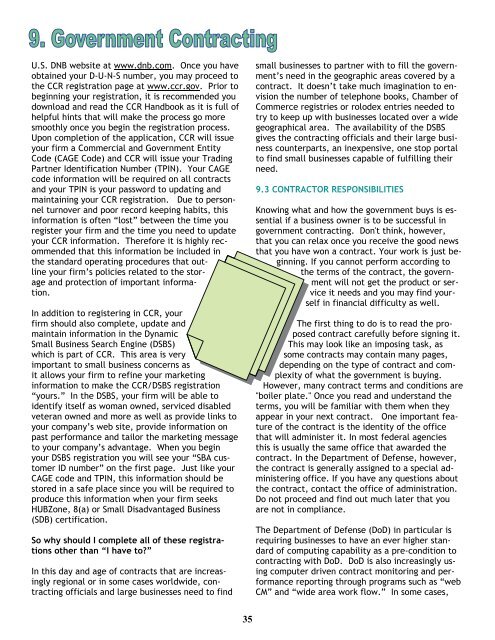


![Residence Hall Application Form [PDF]](https://img.yumpu.com/46340085/1/190x245/residence-hall-application-form-pdf.jpg?quality=85)
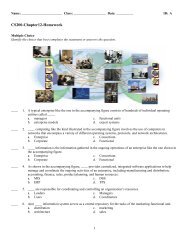


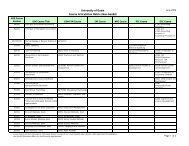
![Modern compiler design [PDF]](https://img.yumpu.com/37285279/1/190x245/modern-compiler-design-pdf.jpg?quality=85)
